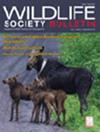Virtual snow stakes: a new method for snow depth measurement at remote camera stations
IF 1.5
4区 环境科学与生态学
Q3 Environmental Science
引用次数: 0
Abstract
Remote cameras are used to study demographics, ecological processes, and behavior of wildlife populations. Cameras have also been used to measure snow depth with physical snow stakes. However, concerns that physical instruments at camera sites may influence animal behavior limit installation of instruments to facilitate collecting such data. Given that snow depth data are inherently contained within images, potential insights that could be made using these data are lost. To facilitate camera‐based snow depth observations without additional equipment installation, we developed a method implemented in an R package called edger to superimpose virtual measurement devices onto images. The virtual snow stakes can be used to derive snow depth measurements. We validated the method for snow depth estimation using camera data from Latah County, Idaho, USA in winter 2020–2021. Mean bias error between the virtual snow stake and a physical snow stake was 5.8 cm; the mean absolute bias error was 8.8 cm. The mean Nash Sutcliffe Efficiency score comparing the fit of the 2 sets of measurements within each camera was 0.748, indicating good agreement. The edger package provides researchers with a means to take critical measurements for ecological studies without the use of physical objects that could alter animal behavior, and snow data at finer scales can complement other snow data sources that have coarser spatial and temporal resolution.虚拟雪桩:一种远程摄像站雪深测量新方法
远程摄像机被用来研究人口统计、生态过程和野生动物种群的行为。摄像机也被用来用物理雪桩测量雪深。然而,考虑到在拍摄地点的物理仪器可能会影响动物的行为,限制了仪器的安装,以方便收集这些数据。鉴于雪深数据本身就包含在图像中,利用这些数据可以获得的潜在见解就丢失了。为了便于基于相机的雪深观测,而无需安装额外的设备,我们开发了一种在R包中实现的方法,称为edger,将虚拟测量设备叠加到图像上。虚拟雪桩可用于雪深测量。我们使用2020-2021年冬季美国爱达荷州Latah县的相机数据验证了雪深估计方法。虚拟雪桩与物理雪桩的平均偏差为5.8 cm;平均绝对偏差为8.8 cm。每台摄像机内比较两组测量值的拟合平均Nash Sutcliffe效率得分为0.748,表明一致性良好。edge包为研究人员提供了一种方法,可以在不使用可能改变动物行为的物理对象的情况下进行生态研究的关键测量,而更精细尺度的雪数据可以补充其他具有粗糙空间和时间分辨率的雪数据源。
本文章由计算机程序翻译,如有差异,请以英文原文为准。
求助全文
约1分钟内获得全文
求助全文
来源期刊

Wildlife Society Bulletin
BIODIVERSITY CONSERVATION-
CiteScore
2.10
自引率
13.30%
发文量
0
期刊介绍:
The Wildlife Society Bulletin is a journal for wildlife practitioners that effectively integrates cutting edge science with management and conservation, and also covers important policy issues, particularly those that focus on the integration of science and policy. Wildlife Society Bulletin includes articles on contemporary wildlife management and conservation, education, administration, law enforcement, and review articles on the philosophy and history of wildlife management and conservation. This includes:
Reports on practices designed to achieve wildlife management or conservation goals.
Presentation of new techniques or evaluation of techniques for studying or managing wildlife.
Retrospective analyses of wildlife management and conservation programs, including the reasons for success or failure.
Analyses or reports of wildlife policies, regulations, education, administration, law enforcement.
Review articles on the philosophy and history of wildlife management and conservation. as well as other pertinent topics that are deemed more appropriate for the Wildlife Society Bulletin than for The Journal of Wildlife Management.
Book reviews that focus on applied research, policy or wildlife management and conservation.
 求助内容:
求助内容: 应助结果提醒方式:
应助结果提醒方式:


